
Mathematical puzzles involving the number 4 have become a popular and engaging way to enhance problem-solving skills. These challenges encourage creative thinking by restricting the use of only one digit, yet allowing a wide range of mathematical operations. Participants are tasked with using basic arithmetic functions and advanced techniques to reach specific values.
In this section, we dive into different strategies for solving such puzzles. From basic operations like addition and subtraction to more complex methods involving exponents or square roots, there are endless ways to approach these brain-teasers. The key lies in understanding how to manipulate the number 4 through various mathematical tools to produce the desired outcomes.
Whether you’re a beginner or an experienced puzzle solver, these challenges provide an excellent opportunity to sharpen your arithmetic skills. By experimenting with different solutions and discovering new methods, you can improve your mathematical flexibility and gain a deeper understanding of number manipulation.
Four Fours Puzzle Solutions Overview
In this section, we explore the fundamental concepts and approaches used to solve puzzles that involve the number 4 and a variety of mathematical operations. These challenges require participants to creatively combine basic and advanced techniques to reach specific numerical results, making them a fun and educational exercise for problem solvers of all levels.
Key Methods for Solving Puzzles
The main approach to these challenges is utilizing the digit 4 in different forms, such as adding, multiplying, or even using factorials and square roots. By applying mathematical operations in various sequences, you can find multiple ways to achieve the desired outcomes. Experimenting with these combinations can help strengthen both basic arithmetic and more complex number manipulation skills.
Common Approaches and Strategies
Effective solutions often involve a combination of simple and sophisticated methods. Using parentheses to alter the order of operations is crucial, as is applying powers and roots. Recognizing patterns in numbers and operations also plays a key role in efficiently solving these types of problems, allowing for quicker and more creative solutions.
Understanding the Four Fours Puzzle
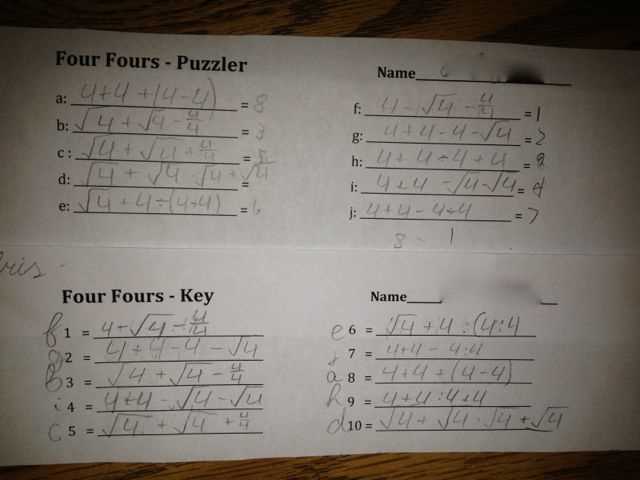
This puzzle is a creative mathematical challenge where participants use the number 4 and various arithmetic operations to generate a range of values. The objective is to manipulate this single digit in different ways, exploring how basic operations and more advanced techniques can lead to the desired results. The challenge lies in how to combine these tools effectively and uniquely to solve each puzzle.
Key Operations Used in the Puzzle
Several operations can be applied to the number 4 to achieve different outcomes. These include:
- Addition: Combining the number 4 with itself or other results to form larger numbers.
- Multiplication: Using multiplication to scale the number 4 to higher values.
- Exponentiation: Applying powers and roots to create new variations of the number.
- Factorials: Using factorials to explore more complex calculations.
- Parentheses: Altering the order of operations to influence the final result.
Strategies for Solving the Puzzle
To successfully solve these puzzles, it’s essential to think outside the box and experiment with various combinations of operations. Here are a few strategies to keep in mind:
- Start by combining basic operations like addition and subtraction to get simple results.
- Use multiplication and division to scale the results in a controlled manner.
- Incorporate factorials and roots to create more complex solutions.
- Don’t hesitate to experiment with parentheses to change the calculation flow.
- Recognize patterns that emerge as you test different combinations.
Step-by-Step Solutions to Common Problems
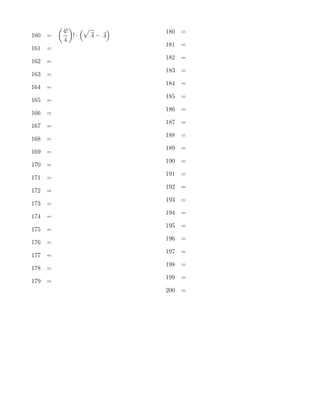
When tackling these types of mathematical puzzles, it’s helpful to break down each challenge into manageable steps. By following a systematic approach, you can uncover different ways to manipulate the number 4 and achieve the desired results. This section provides clear, detailed instructions on how to solve some of the most frequently encountered problems, allowing you to learn and apply various strategies.
Example 1: Reaching a Simple Number
Let’s say the goal is to create the number 5 using only the digit 4. Here’s one way to approach it:
- Start with the number 4.
- Add 4 divided by 4. This gives you 4 + (4 ÷ 4) = 5.
Tip: Keep in mind that division can help create smaller increments that bring you closer to your target number.
Example 2: Reaching a Larger Number
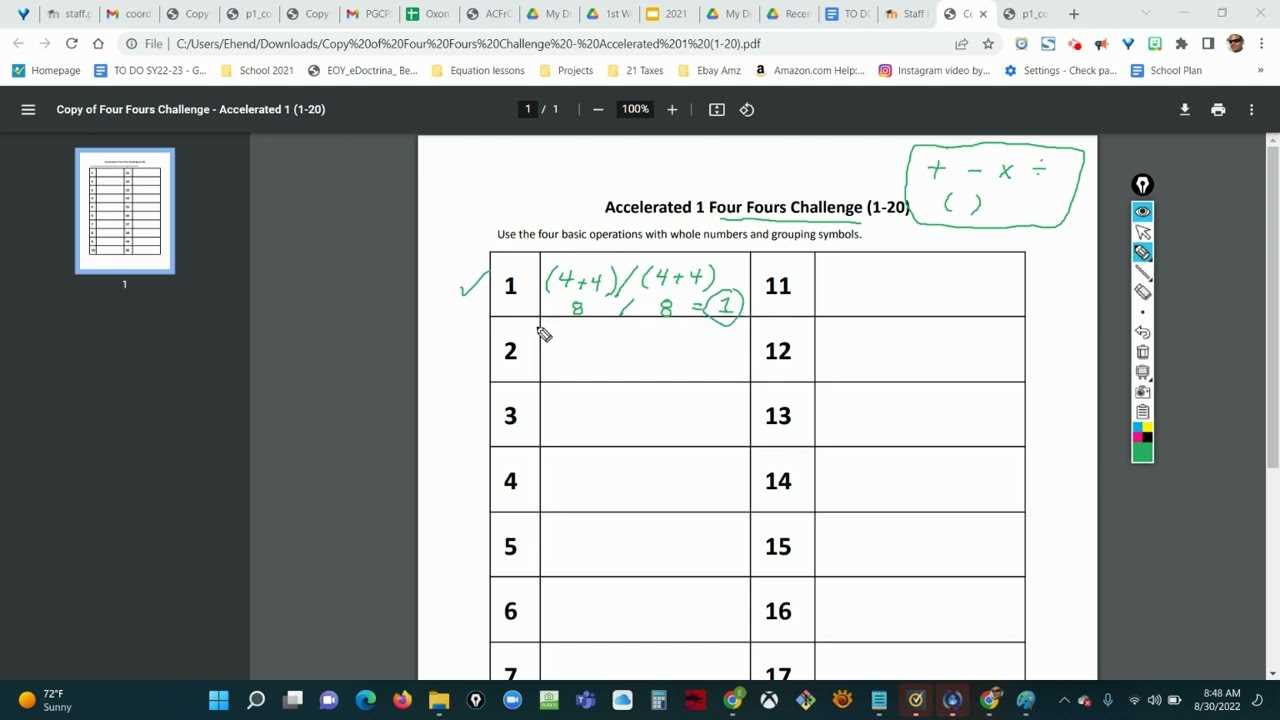
For more complex problems, such as reaching the number 20, the steps become a bit more involved:
- Begin with the number 4.
- Multiply 4 by itself to get 16.
- Then, add 4 to this result: 16 + 4 = 20.
By applying multiplication and addition, you can easily reach the target value.
Why Use the Number 4 in Math Puzzles
The use of a single digit in mathematical challenges offers a unique and engaging way to test problem-solving skills. By restricting the available numbers and focusing on one repeated digit, participants are encouraged to think creatively and explore different combinations of operations. This approach simplifies the problem while still providing a wide range of possible solutions.
Benefits of Using a Single Digit
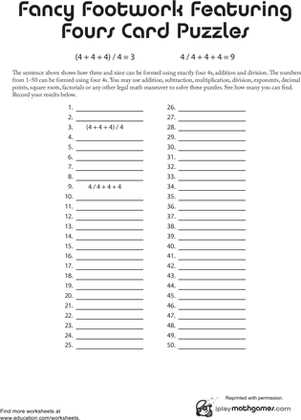
There are several reasons why using the number 4 is particularly effective in math puzzles:
- Encourages creativity: Working with a single number forces you to explore a variety of operations to find solutions.
- Simplifies problem structure: The restriction of using only one digit makes the puzzle more straightforward while still offering complexity.
- Improves mathematical skills: Repeated practice with this approach helps sharpen both basic arithmetic and more advanced techniques.
- Builds pattern recognition: By using the same number, it becomes easier to spot recurring patterns and relationships between numbers.
Applications in Learning and Teaching
Using this approach in educational settings can help students develop a deeper understanding of mathematical concepts. Teachers can introduce such challenges as a fun and engaging way to reinforce skills in:
- Basic operations like addition, subtraction, multiplication, and division.
- Advanced techniques such as factorials and exponentiation.
- Problem-solving strategies and creative thinking.
Exploring Basic Arithmetic Operations
In many mathematical challenges, understanding and applying basic operations forms the foundation of problem-solving. These operations–addition, subtraction, multiplication, and division–are the building blocks that help generate the necessary results, even when working with limited or repetitive numbers. By mastering these fundamental skills, you can unlock a variety of solutions to different puzzles and challenges.
Addition and Subtraction
The simplest operations in any mathematical task are addition and subtraction. These two functions allow you to either combine numbers or reduce them to smaller values. When working with puzzles, you can use addition to increase values progressively, while subtraction helps to narrow down the results. Here’s how both operations can be applied:
- Addition: Adding two numbers or multiple results allows you to gradually approach a target number.
- Subtraction: This operation can be used to reduce values or create smaller, precise differences between results.
Multiplication and Division
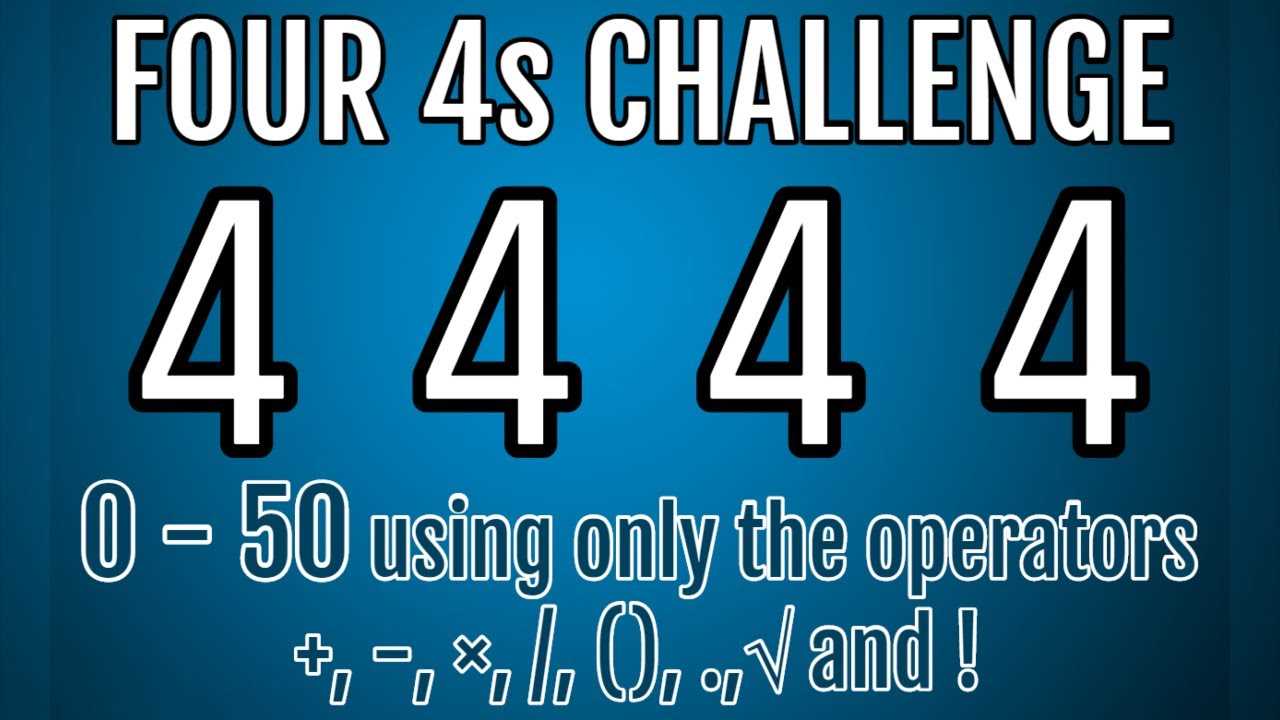
Multiplication and division are slightly more advanced operations that involve scaling numbers. Multiplication allows you to rapidly increase a value, while division helps break down larger numbers into smaller, more manageable parts. Both operations are essential for creating a wider range of solutions, particularly when the goal is to reach a larger or more specific number.
- Multiplication: This operation is useful for scaling numbers to higher values quickly.
- Division: Dividing numbers helps to split values and find fractional parts, providing more flexibility in reaching various results.
Advanced Techniques for Solving Math Puzzles
Once you have mastered the basic arithmetic operations, you can begin to explore more advanced techniques to solve complex puzzles. These methods introduce new ways to manipulate numbers and expand your problem-solving toolkit. By incorporating concepts such as factorials, exponents, and even logarithms, you can achieve more precise and creative solutions. In this section, we’ll explore how to apply these advanced techniques effectively to reach a wider variety of outcomes.
One of the key aspects of solving complex puzzles is understanding how to work with operations that go beyond simple addition, subtraction, multiplication, and division. For example, using powers and roots allows you to create exponential results from a basic number. Similarly, factorials and combinations offer more flexibility by introducing new ways to multiply numbers in unique patterns.
Additionally, understanding how to manipulate the order of operations is crucial. By strategically placing parentheses and adjusting the calculation flow, you can influence the final result in creative ways. These advanced techniques allow you to unlock numerous possibilities, enabling you to solve even the most challenging puzzles with ease and efficiency.
Creating Your Own Math Challenges
Designing your own mathematical puzzles can be a fun and rewarding way to enhance your problem-solving skills. By setting up your own challenges, you not only improve your understanding of arithmetic operations but also boost your creativity and critical thinking. The process involves choosing a target number and finding innovative ways to reach it using specific rules or restrictions. This allows you to explore a wide range of solutions and gain a deeper appreciation for the versatility of numbers.
Choosing a Target Number
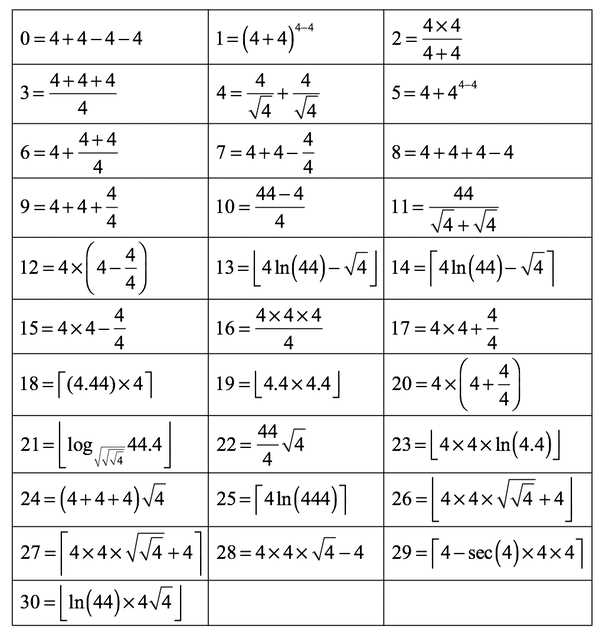
The first step in creating a puzzle is selecting the target number you want to reach. It’s important to choose a number that allows for multiple solutions, as this keeps the puzzle interesting and challenging. Begin with simple numbers, and as you become more comfortable, try selecting larger or more complex values. The key is ensuring that the puzzle remains solvable with the available operations and number manipulation techniques.
Incorporating Operations and Restrictions
Once the target number is set, the next step is to determine which operations will be used to reach the solution. You can limit yourself to basic arithmetic or introduce advanced operations like factorials, roots, and exponents. Additionally, consider adding restrictions on how many times certain operations can be used or whether you can repeat the same number. These constraints will make the puzzle more challenging and engaging for others.
Common Mistakes in Math Calculations
When working with mathematical challenges that involve manipulating numbers, it’s easy to make small mistakes that can lead to incorrect results. These errors often stem from misunderstandings about the order of operations, incorrect use of arithmetic functions, or failing to apply certain rules consistently. Recognizing these common mistakes and learning how to avoid them can improve your problem-solving skills and lead to more accurate results.
Order of Operations Errors
One of the most frequent mistakes in solving these types of puzzles is failing to properly follow the order of operations. The sequence of operations–parentheses, exponents, multiplication and division, addition and subtraction–must be adhered to precisely to avoid incorrect answers. A common error is adding or subtracting before performing multiplication or division, which can drastically change the final result.
- Tip: Always remember to simplify expressions inside parentheses first and then follow the correct order for other operations.
Misapplication of Functions
Another common mistake is incorrectly applying mathematical functions such as factorials, exponents, or square roots. These functions can greatly influence the outcome of the calculation, but they need to be used in the right context. For example, mistakenly applying a square root when an exponent is required can lead to completely different results.
- Tip: Double-check that you’re using the correct operation for the desired result, especially when dealing with more complex functions.
How to Use Parentheses Effectively
Parentheses are a powerful tool in mathematical expressions, allowing you to control the order of operations and clarify the structure of a problem. When used correctly, they can help simplify complex calculations, ensuring that operations are performed in the correct sequence. By strategically placing parentheses, you can manipulate the outcome of an equation and find solutions more efficiently.
Understanding the Role of Parentheses
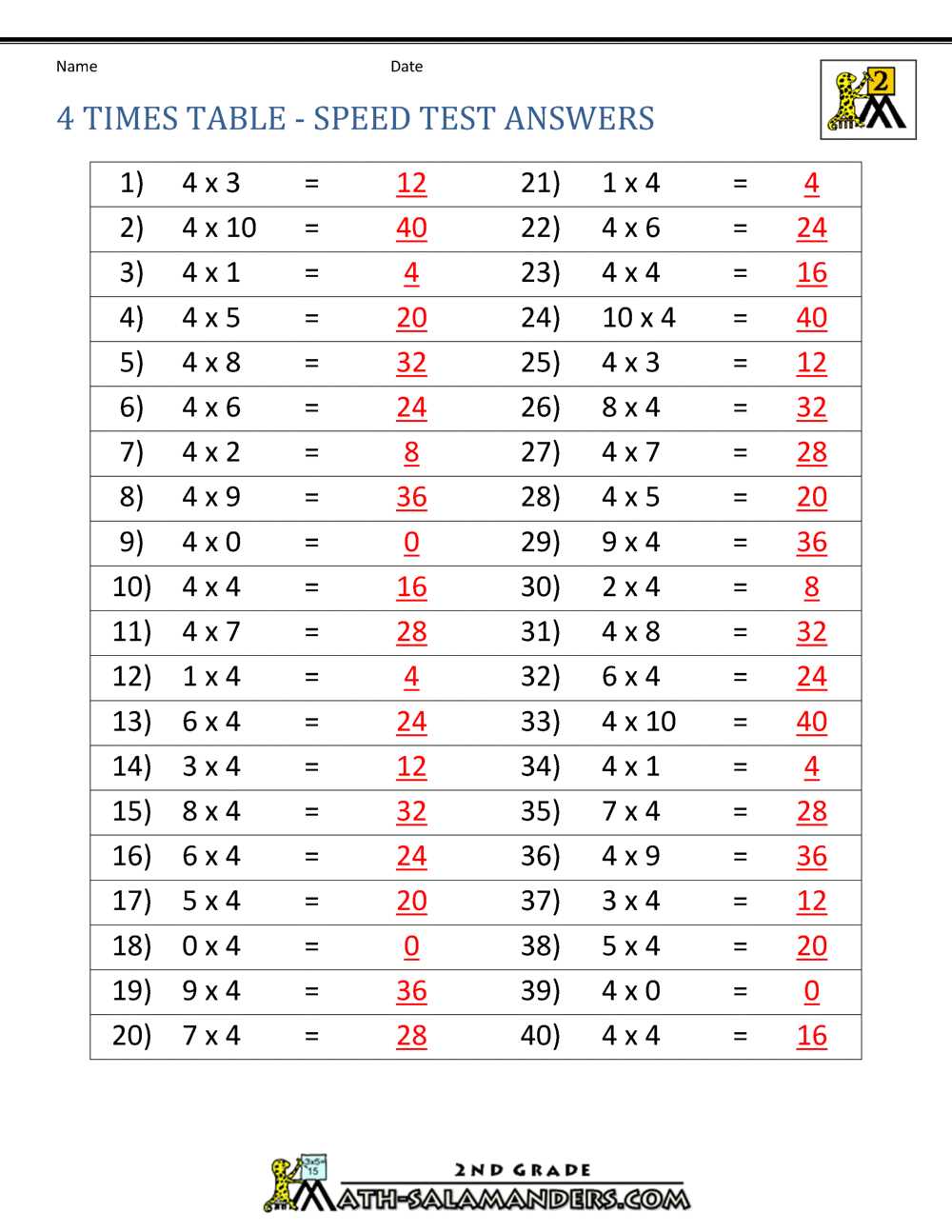
Parentheses are used to group numbers and operations, indicating that the calculations within them should be completed before any operations outside. This ensures that the expression inside the parentheses is evaluated first, regardless of the usual order of operations. Proper use of parentheses can make a significant difference in the accuracy and simplicity of your calculations.
- Clarifies calculation flow: Parentheses help eliminate ambiguity by clearly defining which operations should be performed first.
- Controls grouping: Use them to group numbers together, ensuring certain calculations are completed before others.
- Improves readability: Parentheses make complex expressions easier to read and understand, reducing the likelihood of mistakes.
Tips for Effective Use of Parentheses
To make the most out of parentheses in your calculations, consider the following strategies:
- Use them for intermediate steps: When performing multi-step calculations, place the intermediate results in parentheses to clarify the order of operations.
- Group terms logically: Place terms that should be evaluated together inside parentheses to ensure they are treated as a unit.
- Avoid overcomplicating expressions: While parentheses are useful, using too many can make the expression harder to follow. Keep it simple and only use them where necessary.
Mathematical Operations with Identical Numbers
When solving mathematical puzzles that involve repeating a single number, various operations can be applied to generate different results. By using a combination of addition, subtraction, multiplication, and division, along with advanced functions like exponents or factorials, the same number can produce a wide range of outcomes. The challenge lies in finding the most efficient and creative way to achieve the target value using only the available operations.
These puzzles often require a strategic approach to ensure that the mathematical operations are applied in the correct sequence. Understanding how each operation interacts with the chosen number is key to unlocking multiple solutions. By experimenting with different combinations, you can find innovative ways to reach your desired results while adhering to the rules of arithmetic.
Using Exponents and Square Roots
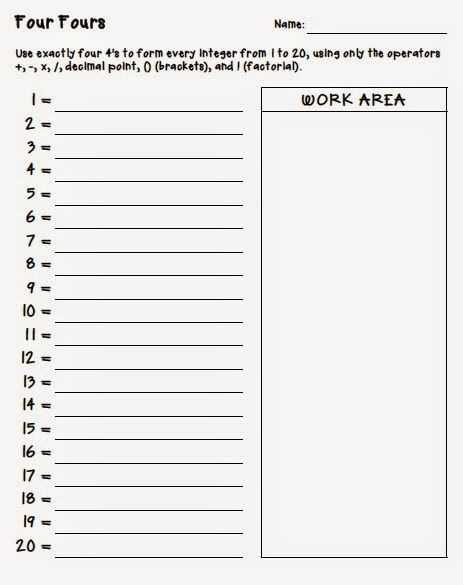
Exponents and square roots are powerful mathematical tools that can transform simple numbers into larger or more manageable values. These operations allow you to represent repeated multiplication and reverse the process of squaring a number, respectively. By incorporating these functions into your calculations, you can expand the range of solutions and introduce new possibilities for reaching specific targets.
Exponents, for example, allow a number to be multiplied by itself a certain number of times, leading to exponential growth. Square roots, on the other hand, find the number that, when multiplied by itself, produces the original value. Using these operations creatively in conjunction with other basic functions can help you solve more complex mathematical challenges and reach higher or more specific results with ease.
Multiplying and Dividing with Identical Numbers
Multiplication and division are fundamental operations that allow numbers to be scaled up or down, opening up new possibilities in mathematical challenges. By using a single number multiple times, these operations enable you to generate large values or break numbers into smaller, more manageable parts. The challenge lies in finding the right balance between multiplication and division to achieve the desired outcome with precision.
In these types of puzzles, the key is to explore how multiplying or dividing the same number repeatedly can lead to a variety of results. Whether you’re increasing the value through multiplication or reducing it via division, understanding the relationship between these two operations is essential for solving complex problems efficiently. By combining multiplication and division in strategic ways, you can unlock a range of creative solutions.
Exploring Factorial Functions in Puzzles
Factorial functions are a powerful mathematical concept often used in puzzles to generate large numbers from smaller values. By multiplying a number by all the integers below it, factorials expand the possibilities within problem-solving scenarios. Understanding how factorials work is essential for applying them effectively, especially in puzzles that require creative manipulation of numbers to achieve a target result.
In these puzzles, factorials are used not only to generate large numbers but also to introduce complexity and challenge. By experimenting with different factorials, you can uncover a variety of ways to approach a given problem. The key to success is recognizing when and how to use factorials to manipulate numbers and reach the desired solution.
| Number | Factorial |
|---|---|
| 1 | 1 |
| 2 | 2 |
| 3 | 6 |
| 4 | 24 |
| 5 | 120 |
Finding Unique Solutions to Challenges
Solving mathematical challenges requires creativity and a deep understanding of available operations. Each puzzle presents an opportunity to explore new approaches and discover unconventional methods for reaching the desired outcome. By thinking outside the box and using various techniques, you can uncover solutions that may not be immediately obvious.
Often, the key to finding unique solutions lies in combining basic operations in unexpected ways. Experimenting with different sequences, applying advanced functions, and carefully considering the structure of the problem can lead to breakthroughs. The beauty of these challenges is that there is no single correct answer; instead, there are multiple pathways to success, each requiring a thoughtful application of logic and skill.
Teaching Math with Number Manipulation Exercises
Using number manipulation exercises is an effective way to teach mathematical concepts and improve problem-solving skills. These activities engage students in critical thinking by challenging them to work with numbers in creative and structured ways. By presenting problems that require a combination of arithmetic operations, educators can help students build a deeper understanding of mathematical relationships and strategies.
Benefits of Using Number Challenges
Incorporating such exercises into lessons offers several advantages:
- Encourages creativity: Students are prompted to think outside the box and explore various combinations of operations.
- Strengthens problem-solving skills: These exercises require students to use logic and strategic thinking to reach solutions.
- Builds confidence: By solving complex problems, students gain confidence in their mathematical abilities.
How to Implement Number Challenges in the Classroom
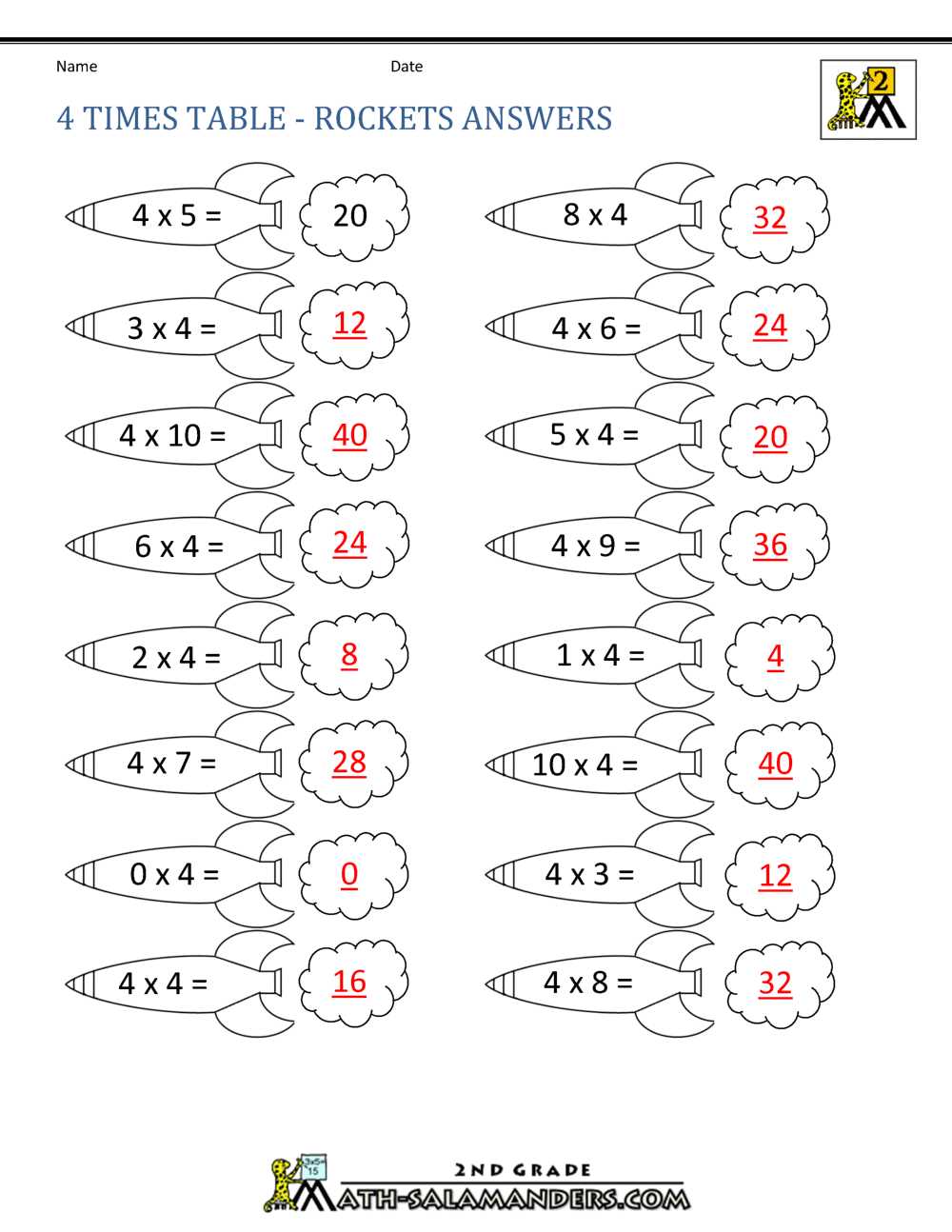
To successfully integrate these exercises into your teaching, consider the following strategies:
- Introduce simple problems first: Begin with less complex puzzles to help students familiarize themselves with the concepts.
- Gradually increase difficulty: As students become more comfortable, introduce more challenging problems to test their skills.
- Encourage collaboration: Have students work in pairs or small groups to discuss their approaches and solutions.
Benefits of Solving Number Manipulation Exercises
Engaging in number manipulation challenges offers numerous benefits for learners of all ages. These exercises require individuals to think critically and strategically as they apply mathematical operations in various combinations to reach a desired outcome. Not only do these challenges improve mathematical proficiency, but they also help develop problem-solving skills that can be applied across other subjects and real-life scenarios.
Skills Developed through Number Challenges
Participating in these exercises can contribute to the development of several important skills:
| Skill | Benefit |
|---|---|
| Logical Thinking | Helps individuals approach problems in a structured way, finding efficient solutions. |
| Creativity | Encourages the exploration of various mathematical operations to discover multiple solutions. |
| Focus and Patience | Requires persistence and attention to detail to identify the correct solution. |
| Collaborative Skills | When done in groups, these exercises foster teamwork and communication. |
Why These Exercises Are Valuable
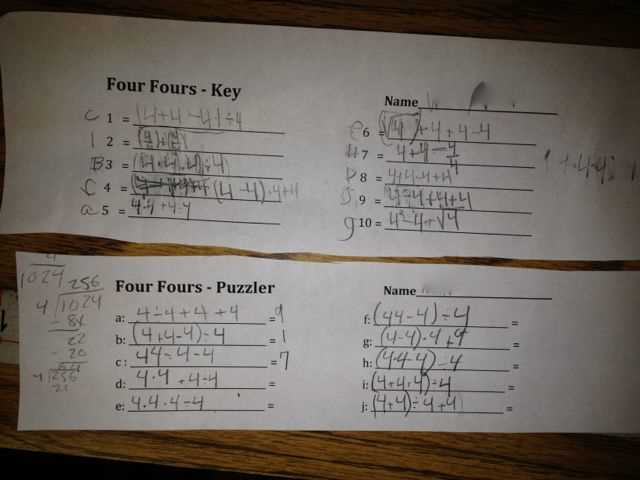
These challenges provide learners with the opportunity to practice key mathematical operations in an engaging and non-repetitive manner. Additionally, the process of experimenting with different combinations and sequences allows for a deeper understanding of mathematical principles. This active learning approach can help improve both confidence and competence in math, making it a valuable tool in educational settings.
Popular Resources for Number Puzzle Solutions
Many enthusiasts and educators seek out tools and platforms that provide solutions and insights for challenging number puzzles. These resources not only offer solutions but also help users understand the reasoning behind each calculation and strategy. By using various websites, books, and apps, individuals can enhance their problem-solving abilities while gaining a deeper appreciation for mathematical creativity.
Online Platforms and Tools are some of the most accessible resources for those looking to explore number puzzles. Websites dedicated to mathematical challenges provide step-by-step solutions, allowing users to learn the strategies employed to solve specific problems. These platforms often offer interactive features such as calculators and logic solvers, which are excellent for both beginners and advanced learners.
Books and Educational Materials also serve as valuable references. Many math books feature puzzles and exercises similar to those found in this genre, guiding readers through essential problem-solving techniques. Educational materials typically include explanations of different operations and how they can be combined to reach a solution. These resources are great for teachers and students alike, offering structured lessons and exercises for practicing various approaches to number manipulation.
Additionally, discussion forums and communities are popular among individuals seeking advice or sharing their own techniques. These online spaces allow users to interact with like-minded individuals, offering a wealth of knowledge and diverse strategies for solving number puzzles. Community-driven platforms often feature threads dedicated to sharing complex solutions and discussing challenges faced during the problem-solving process.